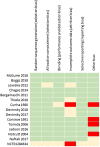A systematic review of cannabidiol dosing in clinical populations
- PMID: 31222854
- PMCID: PMC6710502
- DOI: 10.1111/bcp.14038
A systematic review of cannabidiol dosing in clinical populations
Abstract
Aims: Cannabidiol (CBD) is a cannabis-derived medicinal product with potential application in a wide-variety of contexts; however, its effective dose in different disease states remains unclear. This review aimed to investigate what doses have been applied in clinical populations, in order to understand the active range of CBD in a variety of medical contexts.
Methods: Publications involving administration of CBD alone were collected by searching PubMed, EMBASE and ClinicalTrials.gov.
Results: A total of 1038 articles were retrieved, of which 35 studies met inclusion criteria covering 13 medical contexts. Twenty-three studies reported a significant improvement in primary outcomes (e.g. psychotic symptoms, anxiety, seizures), with doses ranging between <1 and 50 mg/kg/d. Plasma concentrations were not provided in any publication. CBD was reported as well tolerated and epilepsy was the most frequently studied medical condition, with all 11 studies demonstrating positive effects of CBD on reducing seizure frequency or severity (average 15 mg/kg/d within randomised controlled trials). There was no signal of positive activity of CBD in small randomised controlled trials (range n = 6-62) assessing diabetes, Crohn's disease, ocular hypertension, fatty liver disease or chronic pain. However, low doses (average 2.4 mg/kg/d) were used in these studies.
Conclusion: This review highlights that CBD has a potential wide range of activity in several pathologies. Pharmacokinetic studies as well as conclusive phase III trials to elucidate effective plasma concentrations within medical contexts are severely lacking and highly encouraged.
Keywords: cannabidiol; cannabinoid; dose; dosing; therapeutics.
© 2019 The Authors. British Journal of Clinical Pharmacology published by John Wiley & Sons Ltd on behalf of British Pharmacological Society.
Conflict of interest statement
A.S.Y. and S.E.O. are paid consultants for Artelo Biosciences and the UK Centre for Medicinal Cannabis. All other authors declare no competing interests.
Figures
References
-
- WHO . Cannabidiol (CBD): World Health Organisation Expert Committee on Drug Dependence Thirty‐ninth Meeting. 2017. Available from: https://www.who.int/medicines/access/controlled-substances/5.2_CBD.pdf. Accessed July 12, 2019.
Publication types
MeSH terms
Substances
Grants and funding
LinkOut - more resources
Full Text Sources
Other Literature Sources
Miscellaneous



